
 Bill Burhans served as a tour officer with the USMLM Air Team from July 1971 to June 1975. He returned in 1979 to command Detachment 16,
7113th Special Activities Squadron (the Air Team), departing in early spring 1980 following a December 1979 Soviet-originated nasty incident.
He recalls for us a successful tour at the Retzow firing range and unfolds the
background story of a well-known Mi-24A picture.
Bill Burhans served as a tour officer with the USMLM Air Team from July 1971 to June 1975. He returned in 1979 to command Detachment 16,
7113th Special Activities Squadron (the Air Team), departing in early spring 1980 following a December 1979 Soviet-originated nasty incident.
He recalls for us a successful tour at the Retzow firing range and unfolds the
background story of a well-known Mi-24A picture.
The Group of Soviet Forces in Germany (GSFG) was the premier army group within the Soviet Armed Forces. Any new weapons systems deployed outside the boundaries of the USSR appeared here first. This was true for the brand-new Mi-24 HIND A helicopter gunship that was deployed with GSFG in 1973. Throughout my time as a reconnaissance tour officer, I felt most comfortable working in Area A. This encompassed the flat and forested northern part of the GDR. There were fewer large urban areas compared with the industrially developed parts of the country south of Berlin. A lot of lucrative targets of US Air Force interest were located here. If I had the data available for analysis, I would wager my touring schedules coincided most often with periods the Air Team of the United States Military Liaison Mission was assigned to Area A. Whatever the reason, I knew the terrain and targets in the north very well and had many exciting and worthwhile reconnaissance tours up there.
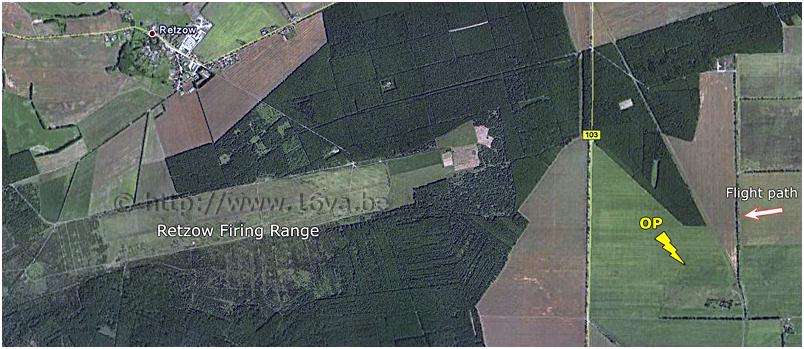

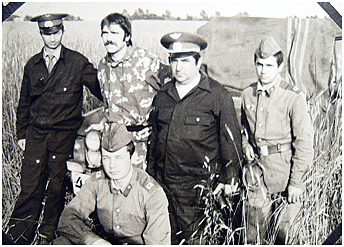 L'équipage de la Range Rover n°4 de BRIXMIS a eu moins de chance lors d'une incursion à Retzow ! Une partie de l'équipe ayant réussi cette
détention prend la pose. On notera l'agent de la Stasi tête nue et la toile posée sur le parebrise lors de l'opération afin d'aveugler le conducteur. © A.Petrukhin.
L'équipage de la Range Rover n°4 de BRIXMIS a eu moins de chance lors d'une incursion à Retzow ! Une partie de l'équipe ayant réussi cette
détention prend la pose. On notera l'agent de la Stasi tête nue et la toile posée sur le parebrise lors de l'opération afin d'aveugler le conducteur. © A.Petrukhin.
The BRIXMIS crew of Range Rover n°4 was not so lucky during a tour at Retzow! Part of the team that conducted the detention successfully
take the pose for the photographer. Note the Stasi agent (bare head) and the canvas on the windshield used to blind the driver. © A.Petrukhin.
One lucrative target in Area A was the Retzow Gunnery/Bomb Range. The terrain in this area was tailor-made for collecting excellent information
on bombing and gunnery tactics, weapons loads, and flight formations. Helicopter gunships stationed at Parchim and Stendal Soviet airfields not
far from Retzow were among the heaviest users of this range.
As opposed to some areas in the northern part of the GDR where targets of interest were sparse, there were many targets in the vicinity of the range.
Thus, if an allied reconnaissance tour, ground or air, was sighted and a report turned in, the narks (the term we lovingly used to refer to the East
German Ministry of State Security goons who surveilled allied liaison mission personnel) had many possible places they would be forced to check. This
circumstance always could be put to very good use. Plus, the woods 4 miles away west of the nearby village of Stuer provided great places to hide and to sleep.
The range itself was located in a wooded area between the villages of Retzow and Ganzlin. Route 103 north out of the city of Meyenburg paralleled the range.
Aircraft would approach the range from the east or southeast over a huge open field. In this field was a low hill called Warenberg, with an elevation of 101
meters above sea level. Warenberg was 2 miles from the center of the range itself. Talk about a well-placed OP!
Retzow Range was the type of target that had to be checked often since there was no established schedule of activity. On March 21, 1975, I was traveling with Master
Sergeant Konrad Spitzenberger, a reconnaissance tour NCO of unparalleled skill and determination.
 Le Ford Bronco n°29 sur une piste tactique. © P.Nikulla/USMLM.
Le Ford Bronco n°29 sur une piste tactique. © P.Nikulla/USMLM.
Ford Bronco n°29 on a tactical trail. © P.Nikulla/USMLM.
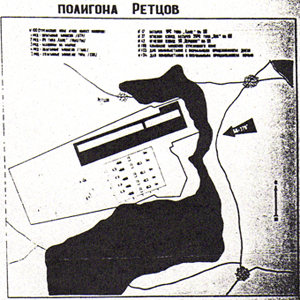 Schéma montrant l'ancien aérodrome de réserve de Retzow et le champ de tir situé au SSE de la piste.
Schéma montrant l'ancien aérodrome de réserve de Retzow et le champ de tir situé au SSE de la piste.
Drawing illustrating the Retzow former grass airfield and the firing range situated SSE of the runway.
We had been tasked to monitor flying activity at Mirow Soviet Airfield,
about 30 kilometers from Retzow and home base of the Soviet 19th Guards Fighter-Bomber Aviation Regiment. So we selected our sleeping location in the Stuer woods from whence
we could hear any Mirow flying activity and monitor the range area as well. We were rewarded for our patience by the onset of a flying program by Stendal-based Mi-24A
HIND A helicopter gunships working the range that bright and sunny day. Although this was not the first sighting of this weapons system, no one had yet produced
high-quality technical photography of this priority airframe, the weapons it carried and attack tactics employed. Konrad and I proceeded to change that situation.
We were operating in a Ford Bronco, our favorite tour vehicle for a several reasons. The main one was that this vehicle in shape and profile looked like the Soviet
UAZ-469 "Jeep" being introduced at that time into the GSFG. We routinely would slap a bit of mud on the distinctive yellow license plate to tone it down a bit and to
make the number illegible so as to make identification of the branch of service of the intelligence collectors difficult. In addition, each of us wore a pile cap with
earflaps similar to the ubiquitous shapka-ushanka headgear Soviet enlisted men wore. This was enough camouflage to induce the bad guys to take us for Soviets. Second,
the Bronco had four-wheel drive capability allowing us to travel virtually wherever we desired. There was one drawback. You had to stop the vehicle, get out and turn
the hubs on the two front wheels to go into and out of 4WD. This was inconvenient to say the least, especially if you were being chased and needed to bail out into a
soft field to escape a detention...
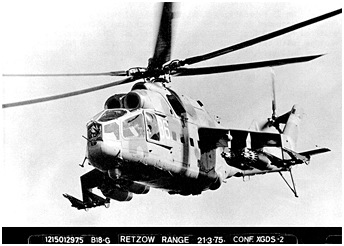
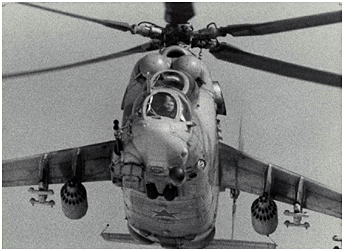 When the Retzow flying activity started, we made a beeline for the Warenberg. The weather was perfect. We decided to position ourselves out in the open,
to obtain the best possible photography. We would simply remain in place until someone chased us away. There was ample room to run, the field was hard and
it would have taken a battalion of troops to block us in.
Warenberg was not only very close to the range, but just happened to be in line with the range targets. We set up on that low hill and began work.
The helicopters flew over us at about 600 feet. As the day wore on, the crews even began to use our vehicle to line up on for their firing passes.
The gunner in the forward compartment often would be seen to rotate the machine gun pod as if to sight in on our vehicle prior to acquiring his target on the range.
Konrad and I came to the conclusion the helicopter crew members must have thought we were a Soviet film crew photographing their exploits. We were not, of course,
but we certainly captured their exploits on film!
We expended thirty-four rolls of Tri-X black and white film (36 exposures each) and more than a dozen 36-exposure rolls of Ektachrome color slide film. No one ever
bothered us at all that entire day. Nonetheless, we had to abort the mission-not because the bad guys had found us and had chased us away. No, it was because we just
flat ran out of our ammunition-film!
Needless to say, I was thunderstruck one day to see my classified photo (shown above left as it appeared as part of Intelligence Information Report 1215-0129-75) when I
turned to page 267 in the 1987-88 edition of Jane's All the World's Aircraft... This was more than a decade before the records of the United States Military Liaison
Mission were declassified (1).
When the Retzow flying activity started, we made a beeline for the Warenberg. The weather was perfect. We decided to position ourselves out in the open,
to obtain the best possible photography. We would simply remain in place until someone chased us away. There was ample room to run, the field was hard and
it would have taken a battalion of troops to block us in.
Warenberg was not only very close to the range, but just happened to be in line with the range targets. We set up on that low hill and began work.
The helicopters flew over us at about 600 feet. As the day wore on, the crews even began to use our vehicle to line up on for their firing passes.
The gunner in the forward compartment often would be seen to rotate the machine gun pod as if to sight in on our vehicle prior to acquiring his target on the range.
Konrad and I came to the conclusion the helicopter crew members must have thought we were a Soviet film crew photographing their exploits. We were not, of course,
but we certainly captured their exploits on film!
We expended thirty-four rolls of Tri-X black and white film (36 exposures each) and more than a dozen 36-exposure rolls of Ektachrome color slide film. No one ever
bothered us at all that entire day. Nonetheless, we had to abort the mission-not because the bad guys had found us and had chased us away. No, it was because we just
flat ran out of our ammunition-film!
Needless to say, I was thunderstruck one day to see my classified photo (shown above left as it appeared as part of Intelligence Information Report 1215-0129-75) when I
turned to page 267 in the 1987-88 edition of Jane's All the World's Aircraft... This was more than a decade before the records of the United States Military Liaison
Mission were declassified (1).
| Hall of Fame |
 |
Retzow Firing Range photo page |  |
notes
(1) That picture has been published in various Western aviation books and magazines during the Cold War. Several other military liaison missions pictures have been released for publication as well during the same period. As that material was classified, the unknown circumstances under which those pictures found their way in unofficial publications are questionable.
 |
Plan du site - Sitemap |  |
